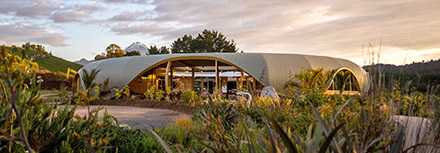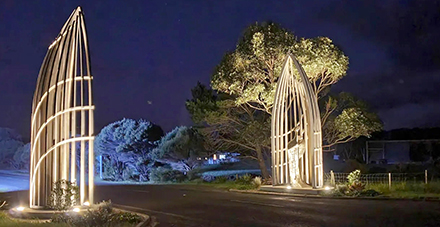A biophilic-inspired building made up of classrooms and community spaces designed to enhance cognitive function and emotional wellbeing has won the 2023 NZ Timber Design Award’s Supreme Award. Source: Timberbiz
Green School NZ’s “Kina” project on a former farm in Taranaki was judged as an exemplary project that demonstrated the beauty, efficiency and sustainability of timber, and was described as a clear winner.
Highly commended in the “supreme” category was Nelson Airport, with judges recognising “the seamless fusion of architecture, engineering and timber,” which “represents a global benchmark for timber architecture and engineering innovation”.
Last night’s awards presentation was hosted by Timber Unlimited at Auckland’s Cordis Hotel. Leaders across the industry celebrated the re-defining of timber as a modern construction material that pushes the boundaries of the possible for architects, designers, engineers and construction professionals alike.
Engineered timber featured strongly throughout, as did hybrid buildings (those incorporating other building materials in the finished project).
“The possibilities for timber aren’t limited to traditional uses anymore,” Timber Unlimited’s Director Dr Robert Finch said.
“We all know timber can be aesthetically beautiful as well as being an impressive building material, and it’s sustainable too.”
Awards Manager Debbie Fergie said that from residential and commercial architectural excellence to innovative uses of engineered wood, to new ways to use specialty timbers, wood was now firmly established as a favourite of forward-thinking architects and engineers.
Sorting another record-breaking number of entries into just 61 finalists, and ultimately into winners and runners-up over 12 categories (up 50% from category choices 10 years ago), requires a profound understanding of architectural design, engineering skills and innovative thinking as well as constructing excellence. The four judges selected this year are leaders in their sectors and were uniformly impressed with the vision and expertise demonstrated by all the entries.
Convening judge David Carradine, a senior structural research engineer with BRANZ and frequent Awards judge, confirmed that for him “there is no limit to what can be done with this material, especially combined with the advances in digital and manufacturing technologies that cater specifically to wood and engineered wood products.”
The other three judges were Jan Stanway, Technical Director for WSP in New Zealand; Andrea Stocchero, senior analyst, Sector and Bio-economy Te Uru Rākau – New Zealand Forest Service; and Judith Taylor, current President of the NZ Institute of Architects.
All judges felt the range of submissions demonstrated the innovation, dedication and creativity that exists within and across the New Zealand timber sector, from architectural and engineering design, manufacturing and fabrication, to “the builders and makers of these beautiful examples of what can be done with one of our greatest national treasures, namely timber”.
With the Supreme Award winner, Green School NZ’s “Kina” project the materials’ whole of life cycle was considered from design process to execution to the end of its useful life, ensuring that timber was as sustainably sourced and manufactured as possible. This allowed it to be a beautiful building now, and at the end of its long life most of the timber elements will be able to be recycled.
“Through sustainable material selection, and innovative building techniques and products, Green School NZ buildings have been by design faster to build, higher performing and less wasteful than most others by quite a margin, with up to 60% less going to landfill,” explained the selected design studio BOON Ltd.
Highly commended in the “supreme” category was Nelson Airport, with judges recognising “the seamless fusion of architecture, engineering and timber,” which “represents a global benchmark for timber architecture and engineering innovation”.
The People’s Choice Award showed Māori Concepts’ Tomomai ki Ahipara in Northland to be a clear winner, with St Hilda’s Anglican Church in Wellington highly commended.
The winners were:
Category 1: Residential Design, Single Family Dwelling:
Winner: Studio house by William Samuels Architects (Nelson)
Highly Commended: Kauri house by Context
Cat. 2: Residential Design, Multi-Unit Dwellings (< 3 storeys):
Winner: 90 Carrington Road by RM Designs & Engco (Auckland)
Highly Commended: Parawai Crescent by RM Designs & Engco (Auckland)
Cat. 3: Commercial & Public Building Design:
Winner: Green School – Kina by Boon (Taranaki)
Highly Commended 1: St Hilda’s Anglican Church, by First Light Studios (Wellington)
Highly Commended 2: St Kentigern’s Preschool, by Smith Architects (Auckland)
Cat. 4: Mid-rise Building Design:
Winner: Clearwater Quay Apartments, by Pacific Environments NZ (Christchurch)
Highly Commended: Homeground, Te Tapui Atawhai by Stevens Lawson Architects (Auckland)
Cat. 5: Interior Design:
Winner: Learning from Trees, by Andrew Barrie Lab (offshore)
Highly Commended: Taunga Waka Rererangi o Kirikiriroa – Hamilton Airport, by Archimedia Waikato Architects (Hamilton)
Cat. 6: Exterior Structure Design:
Winner: Horoeka, by David Trubridge (Rotorua)
Highly Commended: The Elms – Te Papa, Heritage Garden Pavilion, Tauranga, by Matthews & Matthews Architects, Tauranga
Cat. 7: NZ Specialty Timber Award:
Winner: Te Rau Karamu Marae, by Athfield Architects and Te Kahi Toi (Wellington)
Highly Commended: Venice Benches, by Michael Davis (offshore)
Cat. 8: Sustainable Development Award:
Winner: Te Whare Nui o Tuteata – Scion Timber Innovation Hub, by Irving Smith Architects, RTA Studio & Dunning Thornton Consultants (Rotorua)
Highly Commended: Te Noninga Kumu – Motueka Public Library, by JTB Architects (Tasman)
Cat. 9: Hybrid Building Award:
Winner: Wall-E, by Irving Smith Architects (Nelson)
Highly Commended: Dowie Rose house, by Dowie Architects (Auckland)
Cat. 10: Innovative Timber Engineering Award:
Winner: Nelson Airport, by Studio Pacific Architecture, Dunning Thornton Consultants, Gibbons Naylor (Nelson)
Highly Commended 1: Gunyama Park Aquatic and Recreation Centre, Kirk Roiberts (Australia)
Highly Commended 2: Te Whare Nui o Tuteata – Scion Timber Innovation Hub, Irving Smith Architects, RTA Studio & Dunning Thornton Consultants
Cat. 11: Innovative Timber Manufacturing & Technology:
Winner: Lightweight Timber Research Structures, by Andrew Barrie Lab & Batchelar McDougall (staff & students at a New Zealand University)
Highly Commended: Te Whare-iti / Dorking Road house, by Aonui Architecture (Wellington)
Cat. 12: Student Design Award:
Winner: The Vertical Stage, by Gregory Mann (independent)
Highly Commended: The Saucer (Summerhill Charitable Trust), by Thomas Nguyen University of Auckland
Supreme Award:
Winner: Green School – Kina by BOON (Taranaki)
Highly Commended: Nelson Airport, by Studio Pacific Architecture, Dunning Thornton Consultants, Gibbons Naylor (Nelson)
People’s Choice Award:
Winner: Tomomai ki Ahipara, Maori Concepts (Northland)
Highly Commended: St Hilda’s Anglican Church, First Light Studio (Wellington)







